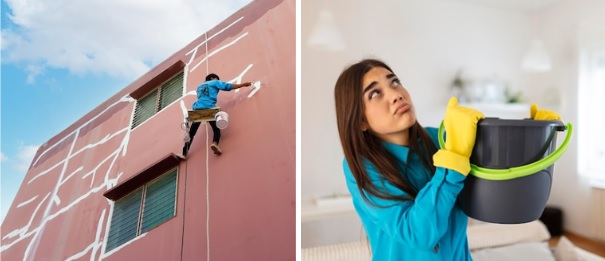
Waterproofing Basics
Basics Of Waterproofing , Methods And Techniques For Home Improvement DIY Projects
Waterproofing is the process of making buildings and structures resistant to the ingress of water, thereby protecting them from structural deterioration and other harmful effects.
It gives the building the ability to protect itself from the harmful effects of seepage and the presence of water. This treatment is commonly applied to buildings, infrastructure, electronic devices, textiles, and various other materials or surfaces that need protection from damage caused by prolonged exposure to water.
For most home improvement projects, such as bathroom renovations, kitchen countertop construction, and other such projects. Waterproofing is a key component of many projects. All new construction projects also need to be treated with suitable waterproofing methods.

The main objective and purpose of the waterproofing process is to create a protective layer that prevents water penetration into the building structure. Seepage and continuous exposure to water and moist conditions can adversely affect the building’s structural members.
Prolonged exposure to water and moist conditions can cause structural deterioration, mould growth, steel corrosion, a reduction in structural strength, and other related issues. Different methods and techniques are used for waterproofing, depending on the type of structure, the specific application, and the materials involved.
Waterproofing Basic Knowledge
Waterproofing Basics
Table Of Contents
This is a complete beginners guide specially compiled for civil engineers, architects, and interior design professionals to understand the basics of waterproofing, various methods, and the best products.
- Waterproofing Methods.
- Importance Of Waterproofing.
- Waterproofing Best Practices.
- Waterproofing Products.
- Bathroom Waterproofing.
- Kitchen Waterproofing.
- Basement Waterproofing.
- Roof Waterproofing.

How to waterproof kitchen. Best practices for kitchen waterproofing.
Importance Of Waterproofing
Waterproofing plays a crucial role in protecting building structures and creating a healthy living environment. It is an integral component of most construction projects.
This treatment is crucial for protecting buildings, structures, materials, and assets from water seepage, maintaining structural integrity, ensuring a safe and healthy environment, and maximising the lifespan and value of buildings and products.
Let us take a look at some of the key reasons why waterproofing is essential:
1. Protection Against Water Damage
Water can cause extensive damage to buildings, structures, and materials. Waterproofing prevents unhealthy conditions due to water penetration, minimizing the risk of structural deterioration, such as cracks, leaks, and erosion. It helps to improve structural strength of the building, maintain the integrity of the building envelope and ensures the longevity of the structure.
2. Creating Healthy Indoor Environment
Water seepage into the building creates unhealthy living conditions. Waterproofing safeguards the indoor environment by preventing moisture intrusion. Moisture can lead to the growth of mold, mildew, and fungi, which can compromise indoor air quality and pose health risks. By preventing water ingress, waterproofing helps maintain a safe and healthy living or working environment.
3. Improves Structural Stability
Excessive water exposure can weaken the structural members of a building or infrastructure. Effective waterproofing treatment helps protect foundations, walls, roofs, and other critical components. Excessive exposure to moisture can cause moisture-induced damage, such as corrosion, rusting, and weakening of structural materials such as steel reinforcement. It ensures the long-term stability and durability of the structure.
4. Improves Energy Efficiency
Waterproofing treatment can contribute to energy efficiency by reducing water infiltration and air leakage. Uncontrolled water entry can affect the thermal performance of a building, leading to increased energy consumption for heating or cooling. By sealing potential gaps and cracks, waterproofing helps maintain proper insulation and reduces energy wastage.
5. Significant Cost Savings
The treatment might initially cost in project cost. However, investing in waterproofing can result in significant cost savings over time. Preventing water damage and associated repairs can be far more cost-effective than dealing with extensive structural issues later on. Waterproofing solutions are relatively affordable compared to the potential costs of water-related repairs, replacements, or renovations.
6. Enhanced Property Value
It can help you improve property valuation. Waterproofing measures add value to properties by ensuring their structural integrity and reducing the risk of future damage. Well-maintained structures with a history of effective waterproofing are more attractive to buyers or tenants, leading to higher property values and increased marketability.
7. Specific Industry Requirements
Many industries have specific waterproofing requirements. For example, in construction, waterproofing is vital for basements, underground structures, roofs, and facades. Electrical and Electronic gadgets installed in the building needs to be protected with effective waterproofing methods.
It protects devices from water damage and enables the development of water-resistant products. Industries such as manufacturing, automotive, marine, and agriculture also rely on waterproofing to ensure product quality and performance.




